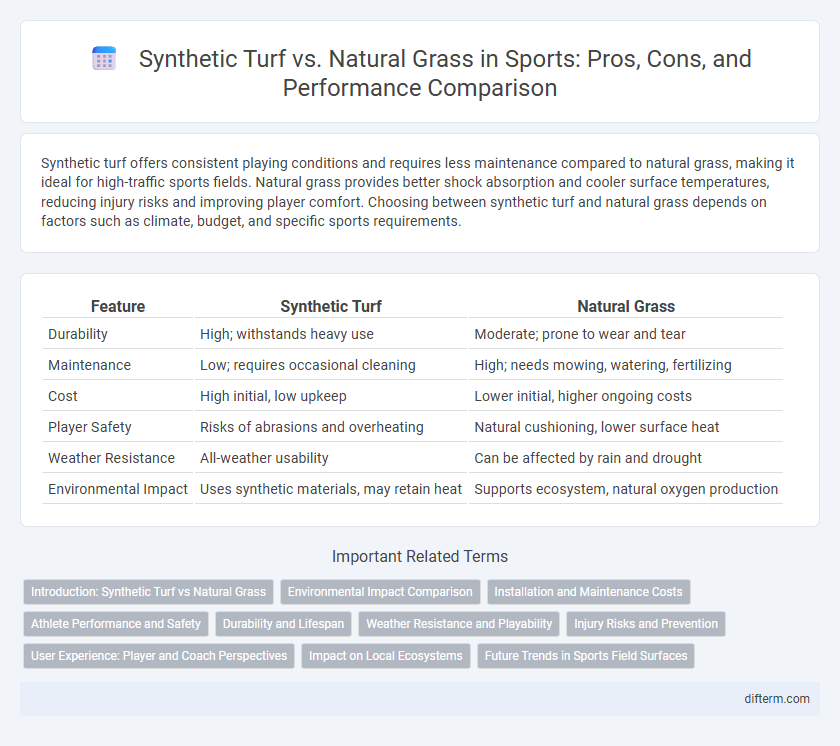Synthetic turf offers consistent playing conditions and requires less maintenance compared to natural grass, making it ideal for high-traffic sports fields. Natural grass provides better shock absorption and cooler surface temperatures, reducing injury risks and improving player comfort. Choosing between synthetic turf and natural grass depends on factors such as climate, budget, and specific sports requirements.
Table of Comparison
| Feature | Synthetic Turf | Natural Grass |
|---|---|---|
| Durability | High; withstands heavy use | Moderate; prone to wear and tear |
| Maintenance | Low; requires occasional cleaning | High; needs mowing, watering, fertilizing |
| Cost | High initial, low upkeep | Lower initial, higher ongoing costs |
| Player Safety | Risks of abrasions and overheating | Natural cushioning, lower surface heat |
| Weather Resistance | All-weather usability | Can be affected by rain and drought |
| Environmental Impact | Uses synthetic materials, may retain heat | Supports ecosystem, natural oxygen production |
Introduction: Synthetic Turf vs Natural Grass
Synthetic turf offers consistent playing conditions, reduced maintenance costs, and enhanced durability compared to natural grass. Natural grass provides better shock absorption and cooler surface temperatures, which can reduce injury risks during sports activities. Athletes and facility managers weigh factors such as performance, safety, and environmental impact when choosing between synthetic turf and natural grass surfaces.
Environmental Impact Comparison
Synthetic turf reduces water consumption significantly compared to natural grass, lowering overall environmental strain in drought-prone regions. However, it often involves non-biodegradable materials like polyethylene and requires energy-intensive manufacturing processes that contribute to carbon emissions. Natural grass supports biodiversity, enhances carbon sequestration, and cools surrounding air, but demands intensive water, fertilizer, and pesticide use that can lead to soil degradation and water pollution.
Installation and Maintenance Costs
Synthetic turf installation typically involves higher upfront costs ranging from $5 to $20 per square foot, but requires minimal maintenance expenses compared to natural grass. Natural grass fields incur lower initial installation costs, generally between $1 and $3 per square foot, although ongoing maintenance such as watering, mowing, fertilizing, and aeration significantly increases annual expenditures. Over time, synthetic turf proves cost-effective due to reduced labor, water usage, and chemical treatments despite the need for eventual resurfacing every 8 to 10 years.
Athlete Performance and Safety
Synthetic turf provides a consistent playing surface that reduces the risk of uneven footing, enhancing athlete performance by allowing faster cuts and improved traction. However, natural grass offers better shock absorption and cooler temperatures, which can decrease the likelihood of heat-related injuries and joint stress. Studies show athletes on synthetic turf face a higher incidence of abrasions and certain lower limb injuries, indicating a trade-off between performance benefits and safety considerations.
Durability and Lifespan
Synthetic turf offers superior durability compared to natural grass, withstanding heavy foot traffic and adverse weather conditions without significant damage. Its lifespan typically ranges from 8 to 15 years, depending on maintenance and usage intensity, whereas natural grass often requires frequent repair and reseeding, especially in high-traffic sports fields. The reduced downtime for synthetic turf makes it a preferred choice for stadiums and sports complexes aiming for consistent playability and long-term cost efficiency.
Weather Resistance and Playability
Synthetic turf offers superior weather resistance by maintaining consistent surface conditions in rain, snow, and extreme temperatures, reducing game cancellations and field maintenance. Natural grass fields can become muddy, uneven, or frozen, affecting playability and increasing injury risk during adverse weather. Athletes often prefer synthetic turf for its reliable traction and bounce, while some still favor natural grass for its softer impact and traditional feel.
Injury Risks and Prevention
Synthetic turf surfaces have been linked to a higher incidence of abrasions and turf burns, with studies showing a 30% increase in non-contact lower extremity injuries compared to natural grass. Natural grass provides better shock absorption, reducing the risk of joint stress and ligament injuries such as ACL tears by approximately 20%. Proper maintenance, use of appropriate footwear, and regular field inspections are critical for injury prevention on both synthetic and natural playing surfaces.
User Experience: Player and Coach Perspectives
Players on synthetic turf benefit from consistent surface conditions that reduce unpredictable ball behavior and enhance speed, while coaches appreciate the low maintenance and reliable playability regardless of weather. Natural grass offers superior shock absorption and a cooler surface, which many athletes prefer for reduced fatigue and injury risk, providing coaches with a traditional playing environment that supports natural game dynamics. The choice between synthetic and natural surfaces significantly shapes training intensity, injury prevention strategies, and game tactics from both player and coach perspectives.
Impact on Local Ecosystems
Synthetic turf alters local ecosystems by disrupting natural water drainage and reducing soil biodiversity compared to natural grass, which supports a wide range of microorganisms and insects essential for ecological balance. Natural grass fields contribute to carbon sequestration and provide habitats for various species, enhancing urban biodiversity and mitigating heat island effects. Conversely, synthetic turf can increase surface temperatures and prevent absorption of rainwater, leading to runoff issues that affect surrounding vegetation and aquatic systems.
Future Trends in Sports Field Surfaces
Advancements in synthetic turf technology are driving its increased adoption in professional sports due to enhanced durability, lower maintenance costs, and improved player safety features. Innovations such as third-generation infill materials and hybrid grass systems combine the resilience of synthetic fibers with the natural feel of grass, optimizing performance and environmental sustainability. Emerging trends indicate a growing preference for eco-friendly, recyclable synthetic surfaces and smart fields equipped with sensors for real-time monitoring of playing conditions.
synthetic turf vs natural grass Infographic

 difterm.com
difterm.com